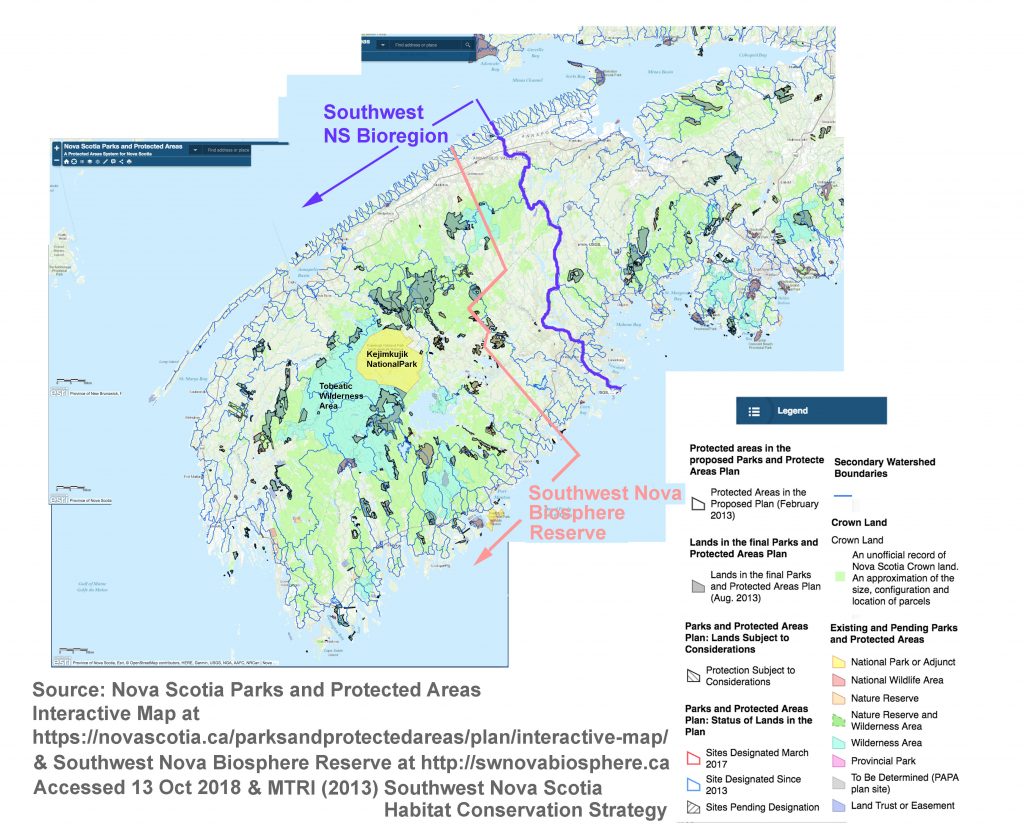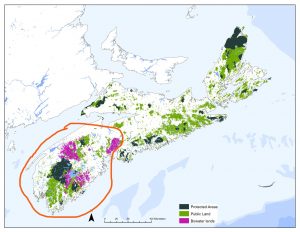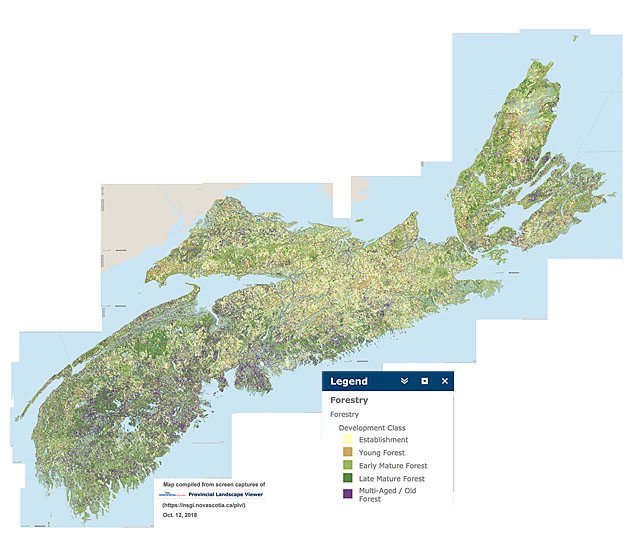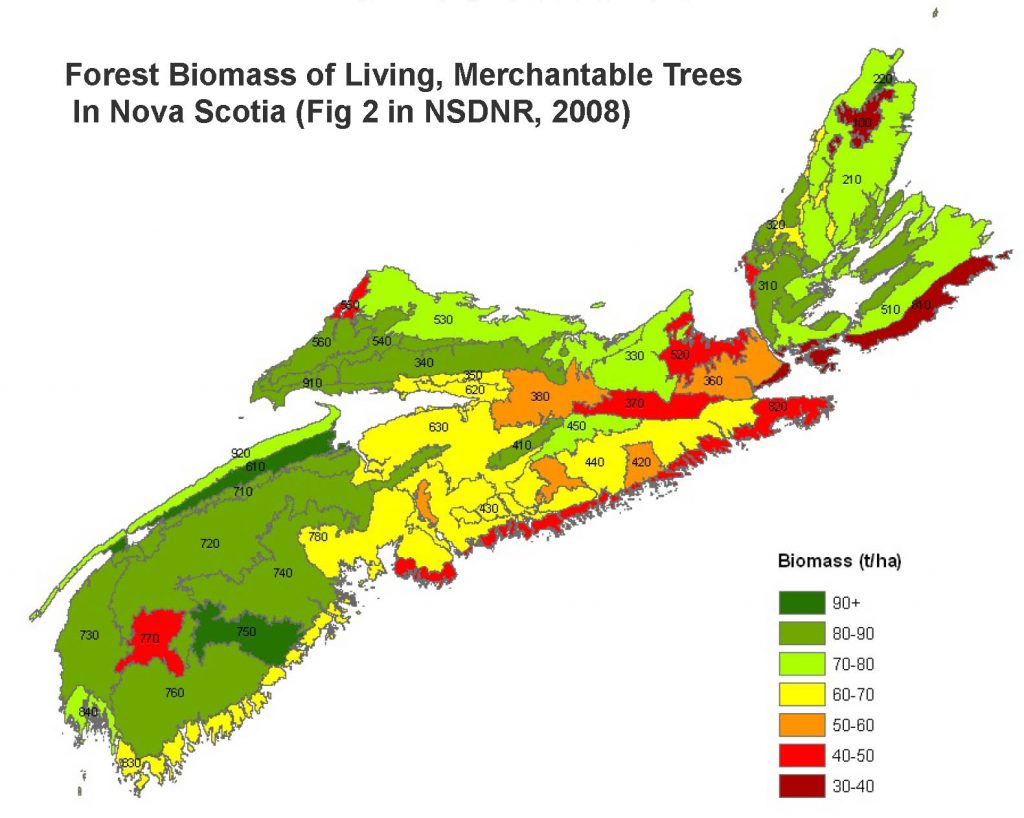Simply put, one cannot make the assumption that “implementing the Lahey recommendations” will help to mitigate climate change
 Candidate Rankin and now Premier Rankin continues to voice loudly his commitment to addressing climate change, in the Speech from the Throne promising that “Nova Scotia will be the first province in Canada to achieve carbon neutrality.”
Candidate Rankin and now Premier Rankin continues to voice loudly his commitment to addressing climate change, in the Speech from the Throne promising that “Nova Scotia will be the first province in Canada to achieve carbon neutrality.”
In the same context he cites changes in forestry:
In the forestry sector, my government will accelerate the implementation of the recommendations of the report of Professor William Lahey to adopt ecological forestry principles, placing protection of the ecosystem and biodiversity in the forefront of forest management practices.
My government is committed to higher value production with lower ecological impacts as we innovate away from industrial forestry to ecological forestry.
It is pertinent to note that the Lahey Report did not cite or even highlight how the proposed changes in forest practices would affect carbon emissions. To illustrate, the word “climate”is cited 9 times, 8 of them referring to effects of climate change and adapting to climate change, 1 to the “business climate”; there is nothing on climate change mitigation.
The Lahey Report recommends small‐scale wood‐energy projects, but there is no accompanying recommendation for Life Cycle Assessments to ensure that they reduce rather than increase carbon emissions.
Simply put, one cannot make the assumption that “implementing the Lahey recommendations” will help to mitigate climate change.
I and many others have expressed particular concern about the impacts of the HPF (High Production Forestry) component on carbon sequestration. I am also concerned about effects of ‘intensive partial harvesting’ on carbon sequestration, if partial harvesting is pushed too hard in the Ecological Matrix.
It is very difficult to conclude that continued net loss of high volume, Multi-aged-Old Growth Forest across Nova Scotia and particularly in SW Nova Scotia will not reduce carbon sequestration in NS significantly. From Biodiverse SW Nova Scotia at Risk (Post on NSFN, October 29, 2018):
=================
Southwest Nova Scotia is “home to 75% of Nova Scotia’s species at risk” and includes a high concentration of Crown land and Parks and Protected Areas:

For sources, view NS Parks and Protected Areas Interactive Map, Southwest Nova Biosphere Reserve, and Southwest Nova Scotia Habitat Conservation Strategy Click on image for larger version.

Western Crown lands, modified from CPAWS map (2012). The Bowater Lands, purchased in 2012 by the province for $117.7 million, are now part of our Crown lands
It’s also a hotspot for Industrial Forestry, especially on the Western Crown lands where WestFor operates.
These two interests are increasingly in conflict, the Lahey Report (which was supposed to sort it all out) notwithstanding, at least as yet while we wait for a government response to the Report.
The map view below explains a lot about this conflict. It shows the distribution of multi-aged/old forest across Nova Scotia.

Distribution of forest in 5 development stages across Nova Scotia, compiled from NS Landscape Map Viewer. Purple = Multi-aged/Old Forest. View larger versions of the map: 2000 px | 4000 px.
(You may have to Save the larger image and open it on your device to view at full size).
More or less (and mostly more), the purple patches are also the forest stands with the highest wood volumes.
Below is a map of forest biomass in living merchantable trees prepared by NSDNR in 2008, showing the much greater overall wood volumes in SW Nova (2002-2006) compared to the rest of the province.

Map from Forest Biomass of Living, Merchantable Trees In Nova Scotia, NSDNR Report by Peter Townsend, 2008
SW Nova has been relatively lightly harvested since that time, particularly in comparison to central and northern NS:

Source: Global Forest Watch Interactive Map. Click on image for larger version. The red patches are mostly clearcuts conducted 2006 to 2017. Purple patches are mainly stands recovering from earlier clearcuts.
So… no wonder Industrial Forestry in NS wants access to SW Nova Scotia and especially the Crown lands, which occupy a large proportion of the area and have been described as the “the last great wood basket” not committed to pulp companies.
But isn’t it OK to harvest on patches of Crown land outside of those PPAs (Parks and protected Areas).. after all there are a lot of them, so what’s the fuss?
=========================
The post goes on to discuss two major issues from a biodiversity perspective: (i) Connectivity of habitat, (ii) Soil nutrient depletion/severe acidification of surface waters.
I could have added a third: carbon sequestration. If there is net removal of wood volume, there will be a correspondingly less carbon storage, except where some of it is used to make long lasting wood structures (which maintains some storage); and except for associated losses of soil organic matter which also reduces carbon storage. Research in Nova Scotia has shown that the latter can be as large as the losses of wood volume and take up to 100 years to recover.
It is the older high volume forests that are now firmly in the scope of L&F/Big Forestry. Appeals via the map viewer to spare “old growth” stands are met with comments such as this one:
Old Growth
The Old Forest Policy protected lands is available on the Provincial Landscape Viewer (PLV) https://novascotia.ca/natr/landscape/. Any stands that were scored and identified as old growth forest have been added to the Old Forest Policy protected layer on the PLV which is current as of March 2020. For more information regarding old growth in Nova Scotia and the Departments work protecting old growth I encourage you to visit our old growth story map at: Old Growth Forests of Nova Scotia (arcgis.com) .
This statement comes while the Old Forest Policy Project is still in progress, with no public consultations to date, almost 3 years after the Lahey report was submitted.
There is widespread suspicion that such defence of harvesting older forests (regardless of whether they qualify for L&F’s current definition of Old Growth or not) by L&F, and approval of proposed old forest sites for harvesting is a pre-emptive move by L&F to protect sites they/Big Forestry want to put into HPF.
Perhaps that’s not true. Regardless, it doesn’t look good. It’s important to note that we are talking only about Crown land forests, it seems that in NS we have to accept that Big Forestry can do as it will on private lands.
Premier Rankin, please forgive some skepticism. I was around when we were told (by all parties) that Nova Scotia would have “one of the cleanest and most sustainable environments in the world by 2020 while achieving economic performance equal to or greater than the national average.”
Premier Rankin, please ask L&F to tell us what the “carbon modeller” L&F hired when you were minister has been doing since he was hired; please instruct L&F to share publicly his results and to seek independent critical review of such results and to share such reviews; please allow him to freely engage the public to explain and discuss carbon storage in our forests; and if the relevant accounting of forest carbon sequestration and impacts of implementing the Lahey recommendations on carbon sequestration have not been conducted, please tell us and give the job out to a fully independent agency through an open competition, preferably targeted at academics with recognized expertise in GHG accounting and modelling.
Premier Rankin, please give us confidence that sincerely, means sincerely. We want you to succeed.
Related
The climate crisis can’t be solved by carbon accounting tricks
Simon Lewis in The Guardian Mar 3, 2021 “Disaster looms if big finance is allowed to game the carbon offsetting markets to achieve ‘net zero’ emissions…Big finance, led by Carney, is planning to massively expand carbon markets. Conceivably, new carbon-based financial products could boom, with little impact on emissions. Just like the sub-prime crisis, few will understand what they bought, and another globe-spanning crash could sweep the world, compounding economic and climate crises causing mass suffering, as we realise again that the Earth owes us nothing. Nature doesn’t do bailouts.”
Climate change: Are forests carbon sinks or carbon sources?
Nancy Harris & David Gibbs, World Resources Institute on weforum.org. Feb 12, 2021 “Overall, the data show that keeping existing forests standing remains our best hope for maintaining the vast amount of carbon forests store and continuing the carbon sequestration that, if halted, will worsen the effects of climate change.While planting new trees (the right way) or letting them regrow naturally can play a role in mitigating climate change (and helping communities adapt to its effects), the new data show that forests that have sprouted up in the past 19 years represent less than 5% of the current global forest carbon sink.”
Elmsdale Biochar initiative provides some good news on the forestry front, but we still need rigorous forest & forestry carbon accounting for Nova Scotia 28Dec2020
Post on NSFN Dec 28, 2020
Addie & Fred Campaigne on the revised Silvicultural Guide for Nova Scotia: Carbon-based silviculture is paramount 12Feb2021
Post on NSFN Feb 12, 2021
Canada’s faulty forest carbon accounting laid bare 30Mar2020
Post on NSFN Mar 30, 2020. Barry Saxifrage, writing in the National Observer, lays out the complicated way Canada reports forest carbon balances, and how that reporting has been changed in recent years to hide some inconvenient truths
Nova Scotia forests, forestry and GHGs 2: Who accounts for the EU’s emissions from bioenergy generated from imported chips?
Post on NSFN Jul 27, 2018
——-
Comment on Social Media
BW, Mar 12, 2021: Note: Paragraph about the “carbon modeller”.This came up during the Public Accounts Committee Proceedings and I got the distinct impression the DLF peeps were thrashing around trying to come up with some reply about what that person is actually doing. We need better answers.
